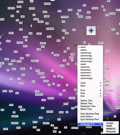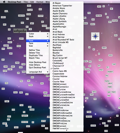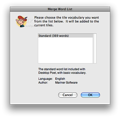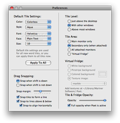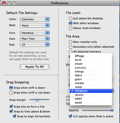Don't you just hate it when you need a word and no matter how long you think about it's slipping through your fingers? You find yourself stunned in front of a mental blockage desperately seeking for a solution. Desktop Poet is the perfect application to solve this problem. As the producer says, if you are a poet, writer, playwrighter, screenwriter, author, educator, student, brainstormer, or just a "doodler" you definitely need it. Desktop Poet instantly offers you hundreds of word tiles right on your desktop, ready to fill your mental gaps. Also, you can explore your artistic side, grouping words into sentences or phrases, developing ideas or even composing prose or poetry. The great thing is that you can apply it to your own needs, because the program allows you to make lists of words by any topic. Of course Desktop Poet has predefined word lists for sports, classic movie stars, celebrities, scientific terms and other generalities.
The Looks The interface is really simple and has most of the standard features in the menu bar. You are able to find information about the program or to change the program's preferences. Default Tile Settings, Drag Snapping, Tile Level, Tile Area, Virtual Fridge and Tile & Fridge Opacity are the preferences available for customizing, and you are also able to enter the Desktop Poet forum.
The Works Desktop Poet's features are quite effective and the simple interface definitely increases its functionality. You may change the word list completely, bringing your own words or just merge the standard word lists with your new list. If you are in hurry, but you do not want to forget a single word or idea you can create your own tile. You can even add an image if you find it more helpful. If you created a poem you can export it to different formats like JPEG, TIFF or HTML and send it over the internet or print it, as the living proof of your creativity. Also the system requirements could hardly be called requirements: 2 MB (megabytes) of memory (RAM) and 4 MB free hard disk space.
One of the most customizable feature is the background with the various textures that it can display below your tiles. Everything else is configurable too: the font, the layout, colors and tile styles or size. Organizing your line of thought may be pretty hard and having the correct visual tool can spare a lot of time that is usually wasted. Here are some features that Desktop Poet offers in order to accomplish that: Duplicate - create a double for a word tile from an active word list; Invert Selection - goes to the previous selection in an active word list; Blink Selection - the selected word tile blinks and so becomes more obvious. The Find feature will search starting from a prefix match, so you should select Find Exact for the exact word. With Define Tiles you are able to link the tile to an online dictionary that automatically gives you the definition. If you think you have duplicate words in your list but you want to be sure use the Match Tiles option to convince yourself. You can also insert Special Characters like mathematical symbols, graphical dingbats or non-Roman script systems.
Organizing your tiles not only decreases their number and makes them more reachable but you can also enhance your vocabulary and increase the vocabulary that Desktop Poet makes available. The trick is to put more than a word on the same tile. The connection between them may be semantical or syntactical, for example one tile might contain the names of the twelve months of the year or the names of Santa's reinders. The point is that the words should be linked to each other in some way but is your job to define the rules. Consider it part of a poet's job. Until you learn your way through your tiles the fastest way to locate a word is to select "Find" and then enter the word.
Desktop Poet has choices for both organized and disordered users. Weather you keep your tiles in a containing environment (a virtual fridge) or randomly on your desktop you will have the same result. The program offers you the possibility of showing your tiles on a coherent background, the virtual fridge pleasing those who enjoy a clear delimitation between the tiles and the other Applications. If your work is not affected by the transparency of the Desktop Poet you can ignore the virtual fridge. The choice is simply a matter of personality. The transparency setting from the Desktop Poet preferences can be helpful in the decision.
The Good Desktop Poet will help you develop your creativity while connecting words at a linguistic level that you don't necessarily reach everyday. You may start by simply playing with the tiles. The rest will come naturally.
The Bad The side effect of choosing the virtual fridge is connected with the drag-selection. If you don't use it you cannot click on the desktop to start a drag-selection of tiles, because you would go through to whatever program is open in that area. You may drag-select outside the virtual fridge by holding down the option key while clicking on a tile. But you should take care because if Desktop Poet is not the active application, the operating system will consider this the "hide all other applications" command.
The Truth Desktop Poet reminds me of the Dadaist manifest. In the end is almost the same concept except for the anguish and the wish to destroy. The point is that Desktop Poet is as functional as you wish it to be.
Here are some snapshots of the application in action:
 14 DAY TRIAL //
14 DAY TRIAL // 
